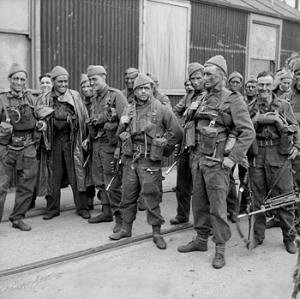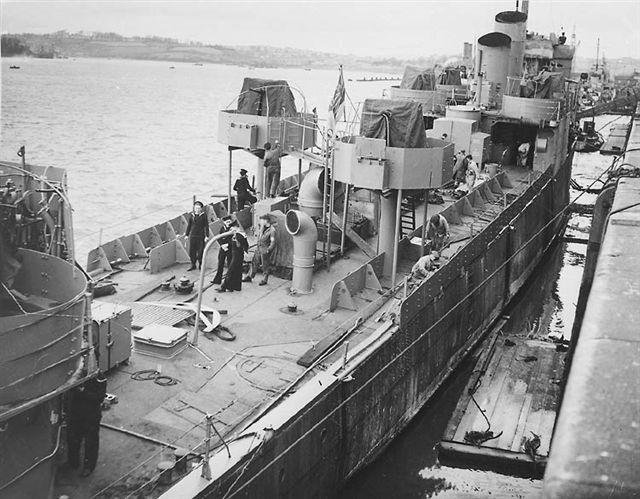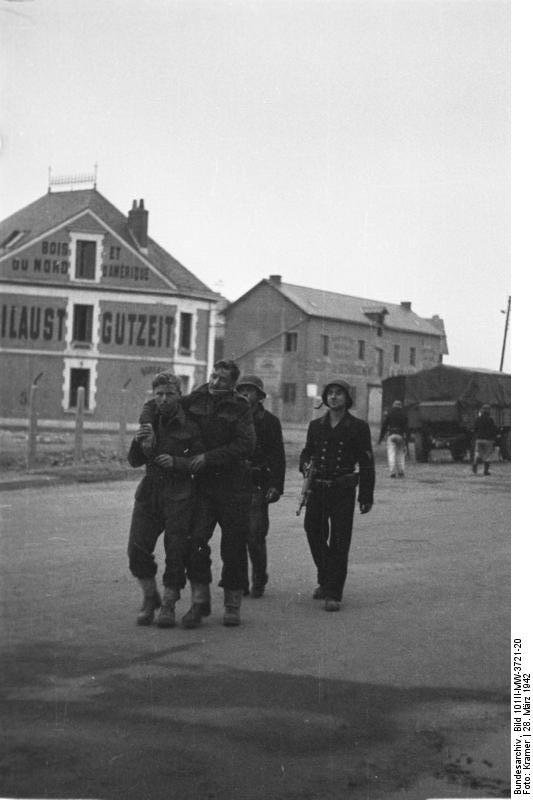Here is the next story from my website worldwariiuntold.com. If your curious of what I mean then check out this link right here https://steemit.com/world/@worldwariiuntold/hello-everyone. But basically, I'm just posting stories from my website which I linked above onto this website to reach a larger audience and to go through my backlog of stories until we get to some new ones. Now enough with all this talk onto the story, you came for.
I’m sure you heard about the more well-known battles of WW2 like D-Day and the attack on Pearl Harbor etc. and rightfully so. These are very important battles and attacks which shaped the war and changed the course of WW2.
Let’s be honest though those battles get covered enough already without me adding my own opinion and writing about them. Still, if you want me to write about them at a later date then just leave me a comment below. Today though I will be talking about the lesser known but still vitally important St Nazaire Raid of 1942 (Operation Chariot) also known as “The Greatest Raid of All”.
The Goal of the St Nazaire Raid

The goal of the St Nazaire Raid of 1942 was to destroy and take out of commission the dry dock which was situated on the west coast of France. Which was the largest in the world when it was built in 1932. It stood as an important strategic advantage for the German navy in World War II. Where they could fix and repair broken down and damaged warships which were damaged in the Atlantic like the mighty Bismark and the Tirpitz.
Which were known for causing headaches and stress to the Royal Navy. So by taking out the dry docks, the British hoped to force the German warships to take a longer trip to another repair station somewhere else on the continent. While doing this it would lead the German warships out to the heavily defended and perilous waters around Britain where the Royal Navy and the Air Force could finish them off.
The Attack Force

There were 611 brave and valiant souls who risked their lives for this daring and courageous raid on the St Nazaire dry docks. Out of the 611, 265 were commandos and 346 were Royal Navy personnel.
Very vital to this plan was the HMS Campbeltown which was a WW1 type destroyer that the Royal Navy acquired from the American Navy in 1940. It was ridden of most of its equipment and reinforced with extra armor at the bow which was also filled with 4.5 tons of explosives.
Also to make it look more like a German ship on approach so they would not get immediately destroyed they cut the chimney stacks. Traveling with the Campbeltown were two destroyers and a fleet of motorboats, some to help out and provide gunfire and some to help evacuate personnel out when the raid was over with.
The German Defense

The Germans had around 5,000 troops accompanying the area. 28 guns, ranging from a caliber of 75mm to all the way up to 280mm which stood on guard to defend the port from sea attacks. They also had in their arsenal of defense 43 anti-aircraft guns which could shoot planes out of the sky if they got to close for comfort, which those, in turn, could be turned around and used to shot out at targets at sea.
The Germans also had a destroyer, an armed trawler, and a minesweeper which were stationed out at the docks permanently. Also, they had 14 other surface ships which were present on the night of the raid and. They also had U-boats positioned out of St Nazaire, but it has been unfortunately lost to history how many U-boats were present and stationed out of St Nazaire.
The day before the raid ironically enough not knowing what was just about to happen, Herbert Sohler, commander of one of the U-boat fleets, said that “an attack on the base would be hazardous and highly improbable”. Little did they know what was about to happen.
The Attack on the Docks

So it happened on the night of 27 March 1942 the seemingly impossible happened. It all started out at 11:30 pm when British bombers began attacking the port. Which drew the attention of the Germans defending the fort as you would expect. So they started shining their searchlights and firing their anti-aircraft guns at the bombers. The bombers had an unusual behavior which made the Germans think something was not right.
Nevertheless, the Germans ceased firing at 1 am on the following day on the 28th March in the middle of the night they also shut off their searchlights to. Although unfortunately for the Germans the British had already entered the Loire estuary.
So then again at 1:22 am the Germans decided to switch on their searchlights again for whatever reason and this time they saw the British fleet of ships heading towards them only this time they were only minutes from the coast.
To buy a few more moments of peace and to get even closer to the shore they identified themselves as friendly ships. The Germans, however, were smarter than that and saw through their deception and then all guns on the dock started to open fire on the ships. As the Campbeltown was approaching the docks to ram them so they could board the docks and so they could set off the explosives on the Campbeltown in hopes of destroying the port and rendering it useless.
They lost two helmsmen (other words people steering the boat) one just outright died and one was injured. Then finally at 1:34 am the Campbeltown crashed into the docks at 19 knots, the immense power of the impact pushing her 33 feet onto the docks. The explosives on board meant to go off after the British personnel had escaped just patiently waiting to be exploded into a big fireball like a Michael Bay movie.
The Boarding Commences

Commandos rushed out of the Campbeltown and went about on the docks. The assault portion of the team dealt with the gun battles with the German defenders. In the meanwhile, while the demolition crew went about setting explosives and destroying important equipment. Even after all of this though the German defenders held their ground and not all spots that were targeted got hit, still many of the areas and the facilities they targeted got destroyed.
Also this Lt. Col Newman did not need to land for this attack, nevertheless he was one of the first ashore and being as a good leader should he lead from the front lines commanding his troops and being apart of the battle himself not just giving orders from a boat. He was in the thick of it to as some of the best leaders in the war were in the front lines handing out orders and being involved in the battle side by side with your troops by your side.
Stranded

While gunfire was being had between the fleet of ships and the arsenal of German firepower upon the docks. As you could expect many British motor gunboats got destroyed and unfortunately because of this not all of the evacuation boats were able to reach the docks to evacuate them to the ships.
With the commandos setting the final priming charges before detonation on the Campbeltown, many of the crew and personnel involved with the raid were evacuated. There was still 100 commandos stuck on the docks to fend for themselves so then when Newman figured out that we are not going to be rescued by sea anymore. He gathered the remaining survivors on the docks and gave them three orders:
- To do their best to get back to England.
- Not to surrender until all ammunition was exhausted.
- Not to surrender at all if they could help it.
The Fight Must Go On

So then having really no choice but to continue to fight on they charged over a bridge leading from St Nazaire’s old town into its new town and they tried to fight their way through the narrow streets.
Unfortunately though as you might have guessed they were largely outnumbered and outgunned and they put up the best fight they could but they were also running low on ammunition and also the Germans were starting to corner them in and surround them so they felt like they had no choice but to give in and surrender.
Somehow though fortunately a handful of men escaped and they made their way south with the help of some nice french citizens. In time they reached neutral Spain and from there made their way home to England.
Aftermath

After the fighting was over with it was still a very tense atmosphere. Since the explosives onboard the Campbeltown were meant to explode at 4:30 am but for some reason did not maybe because of a problem with the fuses or maybe a loose wire God only knows whatever it may be it did not go off at the appointed time.
There was also a growing number of British soldiers who were being held captive at the German headquarters who were just anxiously waiting to see if their hard work and determination had paid off.
So then comes noon and a group of senior German officers and civilians were checking out and inspecting the Campbeltown unbeknownst to them that a great danger of death and destruction was lurking around them ready to go off at any moment.
Then all of a sudden the climax happened and with no warning, the bow exploded with the power of 4.5 tons of explosives. Then as you could probably expect everyone in and around the ship died I would think pretty instantly. Killing all on board and 320 others in the vicinity of the blast.
To top it all of the mission was in all a success the dry dock was rendered useless and destroyed and could not be used for the rest of World War II. Overall the mission was a success they accomplished destroying the dry dock and rendering it useless but it came at a pretty big cost out of the 611 men in all who took part in this mission 169 were killed and 215 more were captured.
To commemorate their amazing bravery and accomplishment there were 89 decorations (medals some like the Victoria Cross) awarded for the men who took part in and carried out the raid and made it a success.
Works Cited
Knighton, Andrew. “Facts About The Greatest Raid of All: The St Nazaire Raid.” WAR HISTORY ONLINE, 26 Mar. 2018, www.warhistoryonline.com/world-war-ii/8-facts-greatest-raid-st-nazaire-raid.html.
“The 1942 Raid on St. Nazaire.” History Learning Site, www.historylearningsite.co.uk/world-war-two/war-in-the-atlantic/the-1942-raid-on-st-nazaire/.
CC BY-SA 3.0, https://commons.wikimedia.org/w/index.php?curid=1707568
By Malindine E G (Lt) War Office official photographer – Transferred from en.wikipedia to Commons by Chrzanko.This is photograph H 18957 from the collections of the Imperial War Museums., Public Domain, https://commons.wikimedia.org/w/index.php?curid=11943310
By Bundesarchiv, Bild 101I-621-2943-33 / Doege / CC-BY-SA 3.0, CC BY-SA 3.0 de, https://commons.wikimedia.org/w/index.php?curid=5413125
By Bundesarchiv, Bild 101II-MW-3722-19 / Kramer / CC-BY-SA 3.0, CC BY-SA 3.0 de, https://commons.wikimedia.org/w/index.php?curid=5478475
By Bundesarchiv, Bild 101II-MW-3721-20 / Kramer / CC-BY-SA 3.0, CC BY-SA 3.0 de, https://commons.wikimedia.org/w/index.php?curid=5478455
By Bundesarchiv, Bild 101II-MW-3717-12A / Kramer / CC-BY-SA 3.0, CC BY-SA 3.0 de, https://commons.wikimedia.org/w/index.php?curid=5478432
By Royal Air Force official photographer – 
By Royal Navy official photographer – Royal Navy, Public Domain, https://commons.wikimedia.org/w/index.php?curid=17571308
Hi! I am a robot. I just upvoted you! I found similar content that readers might be interested in:
https://worldwariiuntold.com/the-st-nazaire-raid-of-1942-story-about-the-greatest-raid-of-all/
Congratulations @worldwariiuntold! You have completed the following achievement on the Steem blockchain and have been rewarded with new badge(s) :
You can view your badges on your Steem Board and compare to others on the Steem Ranking
If you no longer want to receive notifications, reply to this comment with the word
STOPVote for @Steemitboard as a witness to get one more award and increased upvotes!